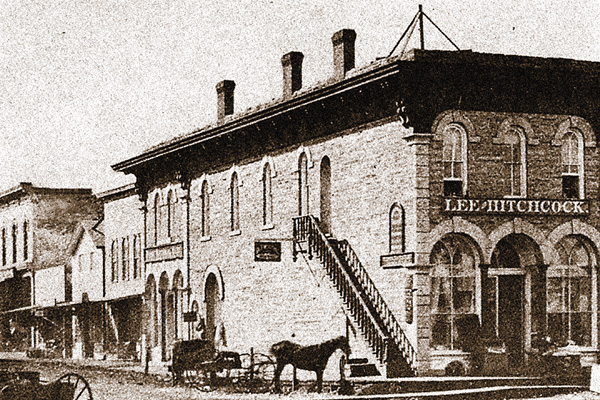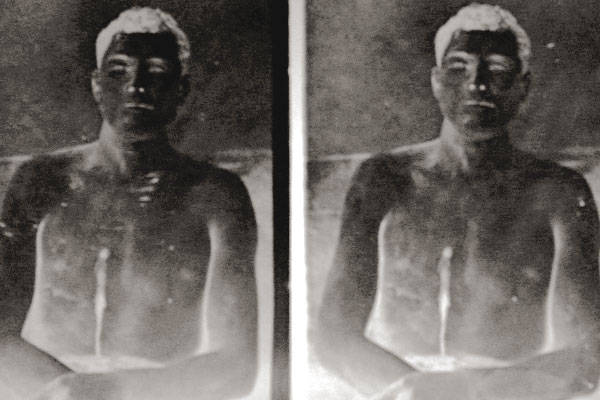 September 7, 1876
September 7, 1876
It’s just past 2:00 p.m. when three horsemen wearing matching white linen dusters dismount in front of the First National Bank in Northfield, Minnesota. After tying their reins to hitching posts, they stroll to the corner, sit on some dry goods boxes and exchange pleasantries with several locals. Two more horsemen wearing linen dusters approach up Division Street from the south. Several minutes later, three more horsemen, also dressed in matching dusters, cross the iron bridge and stop in the center of Mill Square. The three men seated on the corner stand, walk back to the bank, and then go inside.
The two mounted men coming from the south pull up in front of the bank. One of them, Cole Younger, says under his breath, “You’d better close the door,” and they both dismount. Leading his horse, Clell Miller walks to the bank door and shuts it. In the middle of the street, Cole scans the roadway while pretending to tighten the cinch on his saddle.
Several townsmen are suspicious of all the uniformed strangers, and one local, J.S. Allen, walks to the bank and looks in the window. His suspicions confirmed, Allen is confronted by Miller, who has just closed the door. Grabbing Allen by the collar, the outlaw says, “You son of a bitch, don’t you holler.” Allen breaks free and runs up the boardwalk shouting, “Get your guns boys. They’re robbing the bank!”
Cole Younger immediately mounts and pulls his revolver, firing it in the air as a signal for the three horsemen in Mill Square to come quick—they have been discovered.
At almost the same instant, those outside hear a shot from inside the bank. The three horsemen from the square pull their pistols and ride into the engagement, firing and yelling at bystanders to “get in.”
Clell Miller grabs the reins of his horse to mount up. As he steps into the stirrup, birdshot pellets fired by townsman Elias Stacy hit Miller in the face, and he falls backward to the ground. Another townsman, A.R. Manning, aims his Remington single-shot rifle and hits Charlie Pitts’ horse—tied in front of the bank—in the neck, dropping it in its tracks.
Four horsemen ride back and forth before the bank, firing at any who dare to show their face. But instead of cowering, the locals come out with everything they have: flintlocks, fowling pieces with mismatched ammunition, birdshot plunkers, frying pans and rocks. One pesky storekeeper even aims an empty pistol to draw fire and taunt the brigands. A Swede named Gustavson, who doesn’t speak English, comes out of a cellar saloon and is shot in the top of his skull after he fails to respond to one of the robber’s commands. (He dies several days later.)
Suffering from his face wounds, Clell Miller remounts and pulls his pistols. As he turns his horse to ride up Division Street, he is hit again, the bullet severing the outlaw’s subclavian artery, and he falls to the ground in a heap. Cole Younger rides over to Miller and dismounts. Quickly rolling his comrade over, Cole sees the blank stare of death stamped on Miller’s bloody face. As he is leaning over Miller, a bullet rips into Cole’s left hip. The elder Younger grabs Miller’s two revolvers and remounts. Birdshot and buckshot whistle past his ears as Cole again rides to the bank door and pleads for the boys to leave. “I could not imagine what was keeping them so long,” Cole later said.
Hearing the incessant firing from the street and the multiple pleadings of Cole Younger, the robbers inside the bank become increasingly desperate. (See at left: Inside The Bank.)
Seeing a chance to escape, teller Alonzo Bunker dashes out the back door and is chased by Charlie Pitts. Firing twice, Pitts hits Bunker in the shoulder, but the banker escapes. With their plan unravelling at every turn, the outlaws finally heed Cole’s third call and prepare to leave.
Outside, townsman A.R. Manning bravely steps from behind the stairway at the corner of Scriver’s and takes quick aim at outlaw Bill Chadwell (Stiles). Manning fires and Chadwell topples from his horse, shot through the heart. (It was also Manning who hit Cole Younger in the hip.)
“For God’s sake come out,” Cole pleads from the doorway of the bank, more desperate than ever. “They are shooting us all to pieces.”
Charlie Pitts and Bob Younger finally emerge from the bank (the last robber to leave climbs on the counter, turns and shoots a stumbling, semi-coherent Heywood in the head, killing him). Bob immediately runs to the corner to confront Manning and several other townsmen (some claim he was merely heading for his horse, which has been shot dead by Manning). While Bob plays hide-and-seek with Manning through the openings in the steps, a shot from above and across the street rips into Bob’s right arm, breaking the bone at the elbow. He deftly shifts his pistol to his left hand and continues firing.
As the others flee, Cole rides directly into the line of fire to pick up his little brother. A bullet severs one of Cole’s bridle reins, forcing him to guide his mount with his knee and hand. As he turns his horse for Bob to climb aboard, Cole is hit in both the side and shoulder. His hat is also shot off. Another bullet rips away the back of his saddle. (Another account says Cole urged his brother to run, then picked him up a block away.)
The six wounded men give a meek rebel yell as they head south out of town. Although they have survived the Battle of Northfield, their painful ride has just begun.
Odds & Ends
“There were no saddle horses in evidence, and we calculated that we would have a considerable advantage. Wrecking the telegraph office as we left, we would get a good start, and by night we would be safe beyond Shieldsville, and the next day could ride south across the Iowa line and be in comparative safety.”
—Cole Younger, describing their original plan before everything went wrong.
• One of the mysteries surrounding the bank raid is where were the sheriff, the city marshal, or lawmen of any kind? Local tradition says the chief of police hid in a dry goods box in the back of a store and didn’t emerge until after the battle. This legend has been disproved by author and researcher John Koblas, who adds, “there really weren’t any ‘sheriff’ types in Northfield. It is believed the chief of police, Elias Hobbs, was involved in the battle.”
• The safe was not locked! The outlaws needed only to turn the latch and pull the safe door open, but they didn’t even try. What clouded their judgment? Why would men of the James-Younger kind, so savvy in all forms of subterfuge, hardened by years of warfare and lawlessness, be duped by such a simple ruse? (See next page for the answer.)
• In their haste to flee the bank, the outlaws left behind a duster and a grain sack with the initials H.C.A. (What the initials stood for has never been solved.) In the street, the citizens found two dead men, a single spur and two pistols, one an ivory-handled Colt .45. Charlie Pitts’ dead horse yielded a fine saddle (which is prominently displayed in the Northfield Museum).
• After the Youngers were captured at Hanska Slough, a Faribault doctor extracted the ball still in Cole Younger’s hip and gave it to A.R. Manning, the man who had fired it. Manning carried it as a good luck charm for the rest of his life.





